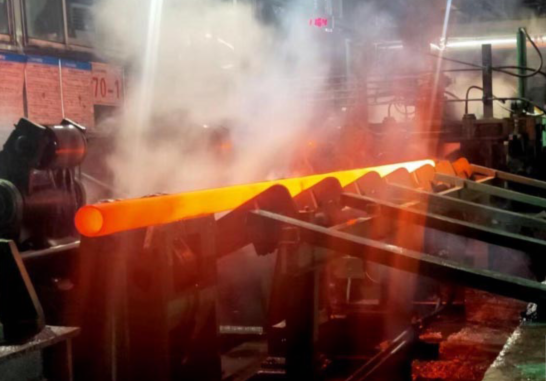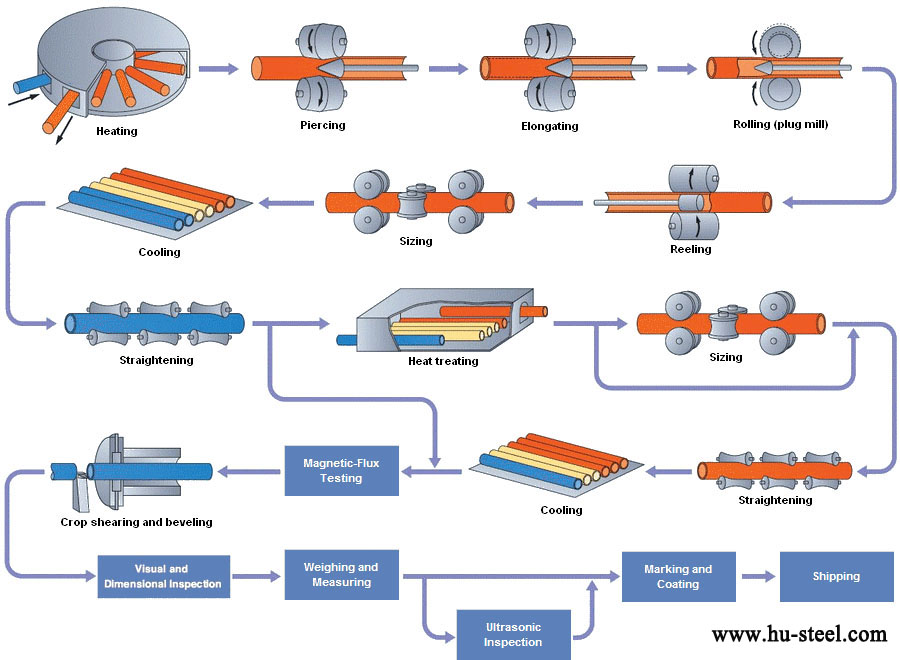Hot-rolled seamless steel pipe is a large category of seamless steel pipe, which is divided according to the production method. Hot rolling is relative to cold rolling, cold rolling is rolling at room temperature, and hot rolling is rolling above the recrystallization temperature. Seamless steel pipes are relative to welded steel pipes. Seamless steel pipes are usually made by perforating round steel and welded steel pipes are usually welded from steel plates in different ways.
Hot-rolled seamless steel pipes are divided into general steel pipes, low and medium pressure boiler steel pipes, high pressure boiler steel pipes, alloy steel pipes, stainless steel pipes, petroleum cracking pipes, geological steel pipes and other steel pipes.

1. Process flow of hot-rolled seamless steel pipe
Hot-rolled seamless steel pipes are generally produced on automatic rolling mills. After inspection and removal of surface defects, the solid tube blank is cut into required lengths, centered on the end face of the perforated end of the tube blank, and then sent to a heating furnace for heating and perforated on a punching machine. During the continuous rotation and advancement of the perforation at the same time, under the action of the roll and the plug, a cavity is gradually formed inside the tube blank, which is called a capillary. And then sent to the automatic rolling mill to continue rolling. Finally, the wall thickness of the whole machine is averaged, and the diameter is sizing by a sizing machine to meet the specification requirements. It is a relatively advanced method to produce hot-rolled seamless steel pipes with continuous pipe rolling mills.
Hot-rolled seamless steel pipe: Round tube billet → heating → perforation → three-roll skew rolling, continuous rolling or extrusion → pipe removal → sizing (or diameter reduction) → cooling → billet → straightening → hydraulic test (or flaw detection) ) → marking → Inventory.

2. Advantages and disadvantages of hot rolling process
Advantage:
It can destroy the casting structure of the ingot, refine the grain of the steel, and eliminate the defects of the microstructure, so that the steel structure is dense and the mechanical properties are improved. This improvement is mainly reflected in the rolling direction, so that the steel is no longer isotropic to a certain extent; the bubbles, cracks and porosity formed during casting can also be welded under the action of high temperature and pressure.
Aisadvantages:
1. After hot rolling, the non-metallic inclusions (mainly sulfides and oxides, as well as silicates) inside the steel are pressed into thin sheets, and the phenomenon of delamination (interlayer) occurs. Delamination greatly deteriorates the tensile properties of the steel through the thickness, and there is the potential for interlaminar tearing as the weld shrinks. The local strain induced by weld shrinkage often reaches several times the yield point strain, which is much larger than the strain induced by the load.
2. Residual stress due to uneven cooling. Residual stress is the stress of internal self-phase equilibrium without external force. Hot-rolled section steel of various sections has such residual stress. Generally, the larger the section size of the section steel, the greater the residual stress. Although the residual stress is self-balanced, it still has a certain influence on the performance of the steel member under the action of external force. For example, it may have adverse effects on deformation, stability, fatigue resistance, etc.
3. For hot-rolled steel products, it is difficult to control the thickness and side width. We are familiar with thermal expansion and cold contraction. Even if the length and thickness are up to standard at the beginning of hot rolling, there will still be a certain negative difference after cooling. The wider the side width of this negative difference, the thicker the thickness, the more obvious the performance. Therefore, for large steel, the width, thickness, length, angle, and edge of the steel cannot be too precise.
Read more: Cold Rolled Seamless Steel Pipe or Cold Drawn Seamless Tubing



